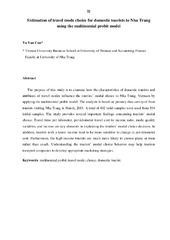| dc.contributor.advisor | Espen, Sirnes | |
| dc.contributor.author | Can, Vo Van | |
| dc.date.accessioned | 2013-06-17T08:54:53Z | |
| dc.date.available | 2013-06-17T08:54:53Z | |
| dc.date.issued | 2013-05-24 | |
| dc.description.abstract | This dissertation has three simultaneous purposes: (1) to investigate the effects of both economic and non-economic factors on the domestic tourist flow to Khanh Hoa province in the long term and the short term; (2) to examine how the characteristics of domestic tourists and the attributes of travel modes influence tourists’ choice of travel mode to Nha Trang, Khanh Hoa; and (3) to investigate how satisfaction and switching barriers influence destination loyalty. To achieve the first purpose, the dissertation has used the general-to-specific approach; for the second purpose, the multinomial probit model has been applied, and structural equation modelling has been used to accomplish the third purpose. For the first purpose, the findings reveal that weather variables have a significant effect on the tourism demand in both the short term and the long term. Furthermore, a positive effect from the lagged dependent variable suggests that word-of-mouth recommendation to potential tourists has good effects for the Khanh Hoa tourism industry. Also, the demand from Vietnamese tourists seems to be highly sensitive to tourism costs. Meanwhile, in the study on travel mode choice, travel time and cost, mode quality, and income are key elements in explaining the tourists’ behaviour. Tourists with a lower income tend to be more sensitive to change in the per-kilometre cost; high-income tourists are much more likely to choose a plane or train rather than a coach. Finally, in the study on tourists’ loyalty behaviour, the findings indicate that both satisfaction and switching barriers have significant effects on this behaviour. Of the multi-components of switching barriers, interpersonal relationships and switching costs have positive impacts, while lack of attractiveness of other destinations has a negative effect on destination loyalty. Furthermore, all three dimensions of tourist satisfaction and overall satisfaction have positive effects on destination loyalty. | en |
| dc.description.doctoraltype | ph.d. | en |
| dc.description.popularabstract | This thesis addresses simultaneously three questions: (1) what are the most relevant factors to explain domestic tourism demand in Khanh Hoa? (2) what kind of travel modes domestic tourists choose for holidays in Khanh Hoa?, and (3) why domestic tourists wish to return to Khanh Hoa for their holidays?. Better knowledge of the domestic tourism demand, travel mode choices of tourists, and factors affecting destination loyalty could be of great assistance to marketers in planning growth strategies for both tourist retention and attracting new tourists, and contributing to promoting sustainable development of the Khanh Hoa tourism industry. To answer the first question, the dissertation has used the general-to-specific approach; for the second question, the multinomial probit model has been applied, and structural equation modeling has been used to accomplish the third question. The findings reveal that economic and non-economic variables have certain significant effects on the tourism demand in both the short term and the long term. In addition, in the study on travel mode choice, travel time and cost, mode quality, and income are key elements in explaining the mode choice behavior of tourists. Low-income tourists tend to be more sensitive to change in the travel cost; high-income tourists are much more likely to choose a plane or train rather than a coach. Furthermore, the findings also indicate that both satisfaction and switching barriers have significant effects on behavior of re-visitation and recommendation to other visitors of tourists. | en |
| dc.description | Papers 1 and 3 of this thesis are not available in Munin: <br/>1. Vo Van Can: 'Effects of economic and non-economic factors on domestic tourism demand – A general-to-specific approach' (manuscript). <br/>3. Vo Van Can: 'Destination loyalty as a consequence of satisfaction and switching barriers' (manuscript). | en |
| dc.identifier.isbn | 978-82-8266-057-0 | |
| dc.identifier.uri | https://hdl.handle.net/10037/5203 | |
| dc.identifier.urn | URN:NBN:no-uit_munin_4913 | |
| dc.language.iso | eng | en |
| dc.publisher | University of Tromsø | en |
| dc.publisher | Universitetet i Tromsø | en |
| dc.rights.accessRights | openAccess | |
| dc.rights.holder | Copyright 2013 The Author(s) | |
| dc.rights.uri | https://creativecommons.org/licenses/by-nc-sa/3.0 | en_US |
| dc.rights | Attribution-NonCommercial-ShareAlike 3.0 Unported (CC BY-NC-SA 3.0) | en_US |
| dc.subject | VDP::Social science: 200 | en |
| dc.subject | VDP::Samfunnsvitenskap: 200 | en |
| dc.title | Modelling tourism demand, travel mode choice and destination loyalty | en |
| dc.type | Doctoral thesis | en |
| dc.type | Doktorgradsavhandling | en |


 English
English norsk
norsk

